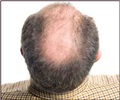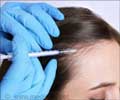Researchers identify a method that would help to end baldness and speed up hair re-growth and new growth using hair follicles.
- Stem cells can regenerate without any injury
- Stem cells can activate cell division and program cell death
- Hair re-growth and new hair growth can be achieved using levels of a growth factor present
TOP INSIGHT
Researchers hope that by focusing on the unique regenerative cells, hair re-growth and new growth can be achieved for repairing damaged tissue or organs and curing baldness.
Read More..
How to Deal With Hair Fall and Promote Re-growth?
Hair is a fascinating subject for scientific study, as it has a root system that grows each strand while it is on the surface of the skin. However, as the filament grows outside the structure, the cells inside are very much dead and no longer need nutrients and are pushed outwards as more dead cells accumulate at the base. Again, the key to getting results is to know the cause (1✔ ✔Trusted SourceHair Loss: Overview
Go to source).
In most animals, hair growth and hair fall are coordinated with the change of seasons and are more easily manipulated over time. So, it seems strange that humans don’t have good control over the limited amount of hair they shed after reaching a certain age. So, the researchers have sought to understand the factors that influence hair loss and what can be done to prevent it.
As millions worldwide search for a way to slow or stop balding, a single chemical has stepped up to the plate — stem cells.
Usage of Stem Cells in Hair Growth and Regrowth
Scientists seem to solve all problems using stem cells. Stem cells can turn into any other type of cells. However, for hair-related damages the problem is that it has been stemmed from them always.The adaptability of stem cells makes them useful for repairing damaged tissue or organs. “In science fiction when characters heal quickly from injuries, the idea is that stem cells allowed it,” said study co-author Qixuan Wang, PhD of the UCR.
Underneath the root of each hair strand is a hair follicle that nurtures hair cells as they grow. The follicle is home to lots of stem cells, which can quickly direct them to perform certain tasks.
Hair follicles originate in the first and second layers of your skin (epidermis and dermis) (2✔ ✔Trusted Source
Hair Follicle
Go to source). In the human body, stem cells spring into action as a response to an injury; however, research studies have shown that TGF-β protein in those stem cells work inside hair follicles, even in the absence of an injury.
“In real life, our new research gets us closer to understanding stem cell behavior, so that we can control it and promote wound healing,” Wang said.
How does TGF-β Control Hair Fall and Promote Regrowth?
TGF-β is a small protein that acts extracellularly and is involved in cell signaling. Interestingly, TGF-β is the only chemical involved in activating and terminating cell division within the hair follicle.As with most chemicals in the human body, it’s the amount of the chemical that makes the difference. In limited amounts, TGF-β activates cell division. When produced in excess, it causes cells to die.
“TGF-β has two opposite roles. It helps activate some hair follicle cells to produce new life, and later, it helps orchestrate apoptosis, the process of cell death,” Wang told.
As with many chemicals, it is the amount that makes the difference. If the cell produces a certain quantity of TGF-β, it activates cell division. Too much of it causes apoptosis.
No one is entirely sure why follicles kill themselves. Some hypotheses suggest that it is an inherited trait from animals shedding fur to survive hot summer temperatures or trying to camouflage.
“Even when a hair follicle kills itself, it never kills its stem cell reservoir. When the surviving stem cells receive the signal to regenerate, they divide, make new cell and develop into a new follicle,” Wang said.
They still need to determine how exactly TGF-β activates cell division to activate follicular stem cells and stimulate hair growth. It helps not only in curing baldness but also in proper healing of hair growth after wound healing.
Findings to Promote Hair Regrowth
To understand the underlying mechanisms of hair follicle cell fate control, scientists developed a novel probabilistic Boolean model on the epithelial cell gene regulation dynamics. First, the model was derived from literature, then refined using single-cell RNA sequencing data.This model predicted that these points could potentially guide future experiments and promote hair growth and prevent hair loss:
- A threshold-like switch in the TGF-β strength may necessitate the dual roles of cell produced less or more quantities, in connection with a protein and tumor necrosis factor (3✔ ✔Trusted Source
A probabilistic Boolean model on hair follicle cell fate regulation by TGF-β
Go to source); - Concordance with the high-activator-low-inhibitor theory of anagen initiation (3✔ ✔Trusted Source
A probabilistic Boolean model on hair follicle cell fate regulation by TGF-β
Go to source); - TNF may be more effective in catagen initiation and may cooperate in a two-step fashion (3✔ ✔Trusted Source
A probabilistic Boolean model on hair follicle cell fate regulation by TGF-β
Go to source); - Predictions reveal the roles in hair follicle cell fate regulations of each gene (3✔ ✔Trusted Source
A probabilistic Boolean model on hair follicle cell fate regulation by TGF-β
Go to source).
“Potentially our work could offer something to help people suffering from a variety of problems,” Wang said.
The bald truth is that by focusing on these unique regenerative cells, researchers hope to promote the complete wound healing that hair growth and regrowth require, and their adaptability makes them useful for repairing damaged tissue or organs and curing baldness.
References:
- Hair Loss: Overview - (https://www.aad.org/public/diseases/hair-loss/causes/fall-out)
- Hair Follicle - (https://my.clevelandclinic.org/health/body/23435-hair-follicle#)
- A probabilistic Boolean model on hair follicle cell fate regulation by TGF-β - (https://www.cell.com/biophysj/fulltext/S0006-3495(22)00428-3)
Source-Medindia
 MEDINDIA
MEDINDIA




 Email
Email










